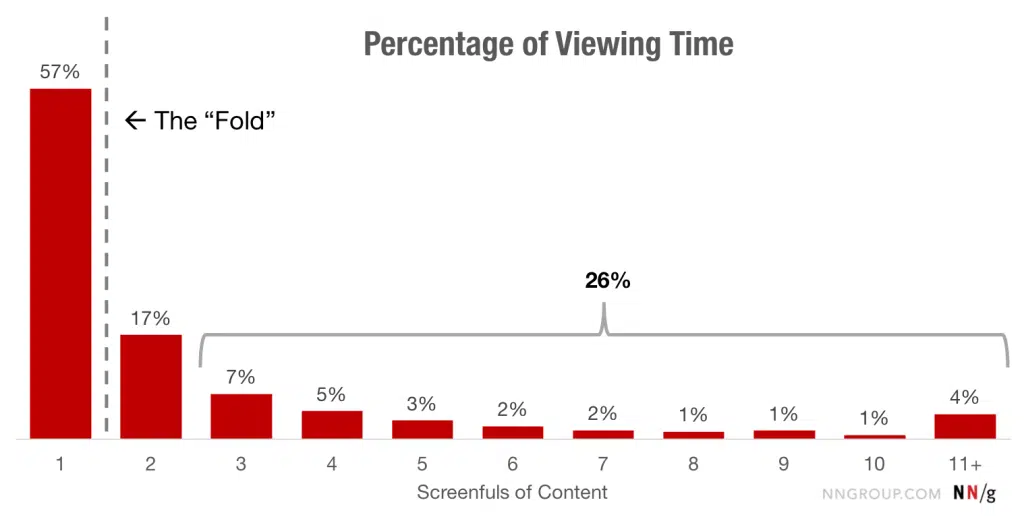
March 30, 2023
What Google Search Continuous Scroll Means for CTRs & Your Business
Google search continuous scroll has brought a fresh, mobile-friendly user experience to millions of searchers.
Rather than clicking to another page to view results outside of the top 10, users can see dozens of SERP links with a simple thumb flick or mouse scroll.
However, as with any Google update or change, marketers wonder about the impacts continuous scrolling will have on their business and SEO strategy, specifically their click-through rate (CTR).
As Google claims nearly 85% of the desktop search market, even modest search algorithm or interface shifts can generate seismic online aftershocks.
So, is there more to continuous scroll than a smooth user experience, and how might it impact your SEO strategy moving forward? Let’s take a closer look.
Google Search Continuous Scroll Hits the Big Screen
For those who aren’t entirely familiar with the Google search continuous scroll desktop function, it’s a tweak to the design of search results.
The results from a traditional Google search would be organized into pages that usually featured 10 results plus paid search ads at the top and bottom of the page. Searchers would go to page two to see results outside of the top 10.
Continuous scrolling allows users to, appropriately, continuously scroll through results without clicking to the next page.
This is similar to how you might scroll through social media feeds on Twitter, Instagram, or LinkedIn. However, while those use “infinite” scroll, meaning they never end, Google limits how many results are shown in a single scroll.
Starting in October 2021, Google allowed mobile users to scroll through the equivalent of four pages, or about 40 results, before reaching a prompt to view more results.
After the mobile launch, Google decided to bring the continuous scroll experience to U.S. desktop users in December 2022.
Currently, desktop users will see around 60 links (six pages worth of results) before reaching the “more results” prompt at the bottom of the page.
Did Page One of Google Search Results Just Get Bigger?
So does this mean that “page one” of Google search now includes more than 10 links? That’s one way to look at it, but there are other important things to consider.
Continuous scroll means that the first 40 search results on mobile devices are no longer spread across four pages. Users now see those results in a single, unbroken scroll.
Meanwhile, desktop users will encounter 60 results in a single scroll rather than their previous distribution across six pages.
Before Google search continuous scroll, each one of the subsequent SERPs after page one was less likely to be visited by users than the last.
Is it reasonable to assume that this extended “page one” has the potential to increase engagement and CTR for businesses that otherwise would have remained buried on pages two, three, four, and beyond?
Promising trends suggest that continuous scroll could be good news for links further down on this expanded “page one.” Practically, though, what continuous scrolling means for engagement and CTR is more complex.
However, rising in SERP rankings and striving for the top result positions remains just as crucial as ever.
If Google’s continuous scroll drives a shift in SEO priorities, it’s a transition from emphasizing a “page one” ranking to striving for a higher rank overall.
RELATED: 8 Ways to Increase Your Search Visibility in Google
How Does Continuous Scroll Impact Impressions?
Before a user clicks a link in Google results, they first have to see said link. That’s why measuring impressions and understanding how continuous scroll impacts them is important.
Traditionally, impressions served as a reasonably reliable metric for tracking traffic rates and fluctuations.
When a user initiated a search, Google Search Console (GSC) counted an impression for every link on the first page. If the user opened the second page, second-page links gained impressions.
However, that equation has changed with the dynamic loading of search results, as it’s easier for users to scroll through 20 search results compared to clicking to the next page.
With continuous scrolling, search results are still loaded in groups of 10, and impressions are typically counted if the user scrolls a link into view. As such, search results 11 through 20, those that previously would have been on page two, might register impressions more so than in paginated results.
What Eye-Tracking Studies Might Tell Us About Continuous Scroll Impressions
Eye-tracking studies seek to learn more about where a user looks when browsing the web.
Historically, many have found that the majority of user time and attention remains focused above the fold—but that might be slowly changing.
For instance, an eye-tracking study by the Nielsen Norman Group compared how those habits have changed over the years.
Their research revealed that as recently as 2010, 80% of page-viewing time happened above the fold. Less than a decade later, in 2018, that had dropped to 57% of the time. 17% of user viewing time went to the “screenful” of content beneath the fold.
For those using the Google search continuous scrolling desktop or mobile function, that roughly corresponds to the second “page” of results, or results 11 through 20. So, significant as that change is, 74% of the cumulative screen-viewing time is devoted to the first two screenfuls or “pages” of a search.

Source: Nielson Norman Group
Generating more impressions is great, but we all want to see searchers click our links in SERPs. It’s no secret the top search results capture the most traffic—does continuous scrolling change that?
How Continuous Scroll Impacts CTR
As is the case with anything related to user habits, engagement, and CTR, there are many factors to consider.
CTRs are influenced by everything from brand preference and loyalty to an assumption of credibility attributed to the top results.
Since continuous scroll has been out for a few months, SEOs have sought to answer the CTR question themselves.
In fact, a recent analysis of search habits found that search results below the sixth position were getting 4% of clicks, compared to 2% before the rollout of continuous scroll.
That means the percentage of user clicks on lower results in the SERPs has doubled since the continuous search rollout.
While results will vary, there seems to be growing evidence that continuous scroll is good news for lower-ranked sites, at least those within the first “scroll.”
That being said, the vast majority of clicks are still going to the top three results, so continuous scrolling doesn’t mean you should lower your rank aspirations or put SEO on the backburner.
How Has Continuous Scroll Changed SEO Strategy?
In short, continuous scroll has changed how marketers must think about ranking on “page one” and highlights new opportunities in search results.
- Businesses with links in the top 40 to 60 spots of SERPs but not in the golden top 10 are no longer confined to page two and beyond, where impressions and clicks were few and far between.
- Page-viewing and CTR trends have revealed that users are increasingly willing to venture below the top few search results.
- CTR rates for links beneath the top six on the SERPs have doubled since the rollout of continuous scrolling.
- The new paradigm established by continuous scrolling suggests that every place a link is boosted in the SERPs is likely to translate into substantial value for the business.
- An investment in effective SEO could now yield a significant ROI for a variety of businesses that may not have been possible a couple of years ago.
What Continuous Scroll Hasn’t Changed
While Google’s introduction of continuous scrolling has deepened and broadened the profit potential of SEO for a range of businesses, many fundamentals remain unchanged.
- Despite user behavior trending toward that increased willingness to dip beneath the top of SERPs, the top spots are still the most popular and profitable.
- The top six spots on the SERPs enjoy 96% of CTRs.
- The visibility and financial benefits of boosted SERP ranking tend to be cumulative the closer it gets to the top.
- Those benefits can even be exponential for a business once its link breaks the vaunted top 10, particularly the top six, and more so for the top three.
How Should Your Business Respond to Google Search Continuous Scroll?
The bottom line: Google search continuous scroll hasn’t changed how absolutely crucial reputable SEO strategies remain for a modern business’ online success.
SEO best practices, such as optimizing on-site content, building internal and external links, and tracking your rankings over time, are still a priority. Whether you handle these efforts in-house or partner with an agency for SEO services, the fundamentals remain the same.
Keep in mind that continuous scroll is just one of many SEO updates to know. Staying on top of each update can be challenging, but it is vital to maintaining your search ranking and capturing organic traffic.
Partner with VELOX Media to Optimize Your Search Rankings
Continuous scroll has changed a lot, and VELOX Media is prepared to help you navigate this new search landscape with proven SEO strategies to help you grow your search engine visibility.
VELOX is internationally recognized as an elite leader in the digital marketing space. As a Google Premier Partner ranked by Google among the top 3% of agencies worldwide, VELOX has generated exceptional client success by focusing on a reliable ROI-driven approach.
Our SEO, content, marketing, and technology professionals deliver a dynamic suite of services specifically tailored to build your business and optimize your search engine visibility. Those services include organic search marketing optimization, paid media, web development, and more.
Contact VELOX Media to learn more about our SEO services.